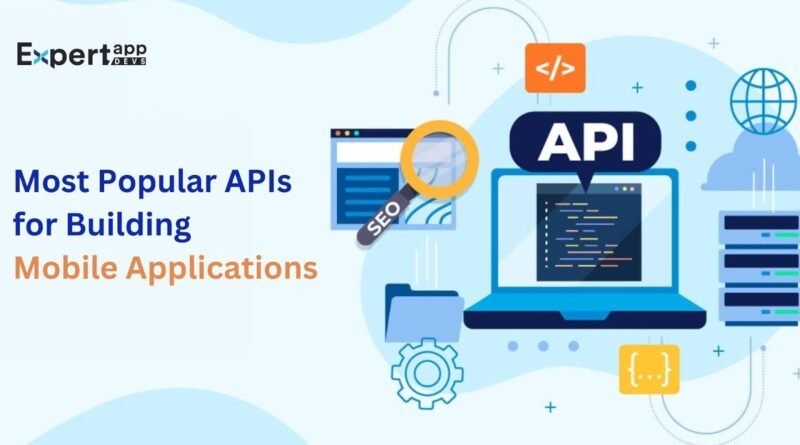Most Popular APIs for Building Mobile Applications
These days, smartphone apps are almost a part of every day. Apps provide connection, convenience, and enjoyment from social networking to e-commerce. Still, creating a responsive, feature-rich, user-friendly mobile application is no simple chore. Here is where application programming interfaces, or APIs, find use.
According to Slashdata, nearly 90% of developers are using APIs in some capacity. APIs let developers include many capabilities and mobile app development services in their projects without starting from nothing.
The most often used trending APIs for creating mobile apps will be discussed in this post, along with ideas on their usage, advantages, and ways you may improve the app creation process.
Google Maps API
Overview:
Google Maps API is among the most often used APIs in creating mobile apps. It lets developers include location-based services, geolocation, and maps into their applications.
Key Features:
- Convert addresses into geographic coordinates and vice versa via geocoding and reverse geocoding.
- Add 360-degree panoramic pictures from street-level perspectives.
- Find the optimum paths and lengths between many sites using directions and distance matrix.
- Get comprehensive details on millions of locations all around, including opening hours, pictures, and reviews.
Firebase
Overview:
Firebase is a complete mobile and online application development tool developed by Google, offering a range of services, including a potent set of APIs for backend development. It lets developers create applications without control of infrastructure quicker.
Key Features:
- Email, social login, and phone verification provide safe and configurable user authentication.
- Store and sync data across all your clients in a real-time database.
- Flexible, scalable database for serverless app development.
- Notify consumers on several platforms with messages and alerts.
- Real-time crash reporting, known as “crashlytics” enables developers to monitor, prioritize, and resolve stability concerns.
Stripe API
Overview:
An excellent tool for managing online payments and financial transactions is the Stripe API. It lets developers include dependable and safe payment processing into their mobile applications, enabling various payment options.
Key Features:
- Accept credit and debit card payments, bank transfers, and digital wallets like Apple Pay and Google Pay.
- Manage subscriptions and regular payments with easy help from subscription billing.
- Support of more than 135 currencies and many payment systems worldwide.
- Modern machine learning systems identify and stop fraudulent transactions.
- Reporting and analytics allow one to track corporate performance through comprehensive transaction reports and insights.
Twilio API
Overview:
With SMS, audio, and video, among other communication tools, Twilio API is at the top of the API list that lets developers easily include these elements in their mobile apps. From customer service to two-factor authentication to video conferences, Twilio provides a consistent answer.
Key Features:
- SMS and MMS messaging lets you send and receive text messages anywhere.
- Make and receive online voice calls using call recording and conference tools.
- Use configurable UI components to include premium video calls within your app.
- Create in-app chat systems with multimedia support, message history, and alerts using programmable Chat.
- You improve security by implementing two-factor authentication (2FA) by SMS, phone, or email.
OneSignal API
Overview:
Popular push notification system OneSignal offers APIs for delivering alerts across iOS, Android, and web platforms. It helps developers to involve consumers with relevant and timely messages.
Key Features:
- Send users focused push alerts depending on their choices, location, or behavior.
- Show tailored messaging within the app to involve users without interfering with their experience.
- Targeting and segmenting users depending on demographics, activity, and other variables for tailored alerts helps to ensure individualized messages.
- A/B testing allows one to maximize user involvement by testing many alert systems.
- Track and evaluate notification performance to guide next campaigns.
Facebook SDK
Overview:
The Facebook SDK offers a collection of tools and APIs meant to let developers include Facebook’s social elements in their mobile applications. Looking to take use of Facebook’s large user base, this includes social login, sharing, analytics, and adverts, thereby providing a useful tool for applications.
Key Features:
- Let people log in using their Facebook credentials on your app.
- Share materials from your app to consumers’ Facebook feed or tales.
- Facebook Analytics helps you to understand user activity.
- Target certain user groups and monetize your app using Facebook ads.
- Track user behaviors within your app to evaluate involvement and performance.
Cloudinary API
Overview:
One cloud-based tool offering APIs for media asset management, including photographs and videos, is Cloudinary. It guarantees great speed and optimization by letting developers upload, store, handle, and distribute media effectively.
Key Features:
- Ideally, photographs and movies should be saved in the cloud.
- Resizing, cropping, and adding effects to photographs and videos are among the on-demand alterations you may make.
- Deliver rapid loading times through ideal media over a worldwide Content Distribution Network (CDN).
- Automatically enhance photos and videos for various devices and screen width.
- Tag, metadata, and sophisticated search features help you to organize and control your media collection.
Conclusion
Mobile app development depends heavily on APIs as they let creators include strong capabilities and services. Using these APIs can help you create a better product for your consumers whether your project is a primary or sophisticated and feature-rich platform. It will also help you simplify the development process.
Maintaining a competitive advantage depends on keeping current with the most recent and effective APIs as mobile app development develops. You should hire mobile app developers for selecting appropriate APIs for your application, which will help you concentrate on developing an exciting and user-friendly experience that satisfies your audience’s demands and makes the best use of development time and resources.



